266 CD / Johann Sebastian Bach: Partitas Part 2 BWV 827, 828, 829
Description
It's been a long time coming for this second part of Johann Sebastian Bach's partitas played by Evgeni Koroliov. The Steinway D grand piano from the first volume is now permanently installed in a beautiful church in Wernigerode. The recordings of Partitas 3 and 5 were made there. Other issues also delayed progress, including the relocation of TACET's premises. And finally, we're all not getting any younger. Who could say otherwise? This takes its toll in the form of slower work. Only a few things are timeless, and that includes the music of Johann Sebastian Bach. The way in which Evgeni Koroliov immerses himself in this ‘eternal’ music, elevating it to a timeless presence, as if it were created in this very moment, changes my perception of time. I absorb its flow. I agree with its passing...
7 reviews for 266 CD / Johann Sebastian Bach: Partitas Part 2 BWV 827, 828, 829
You must be logged in to post a review.

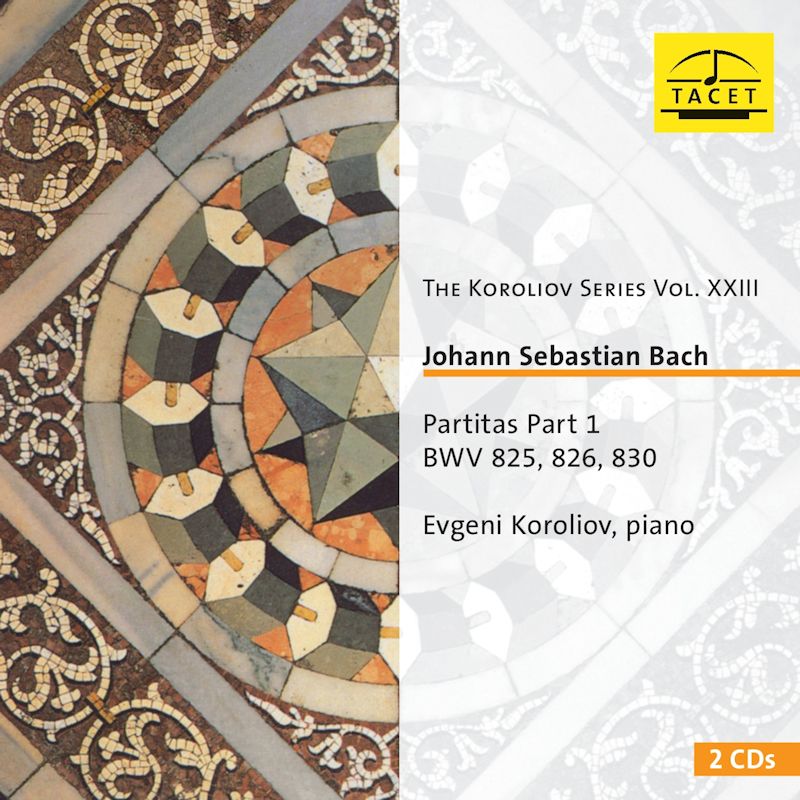
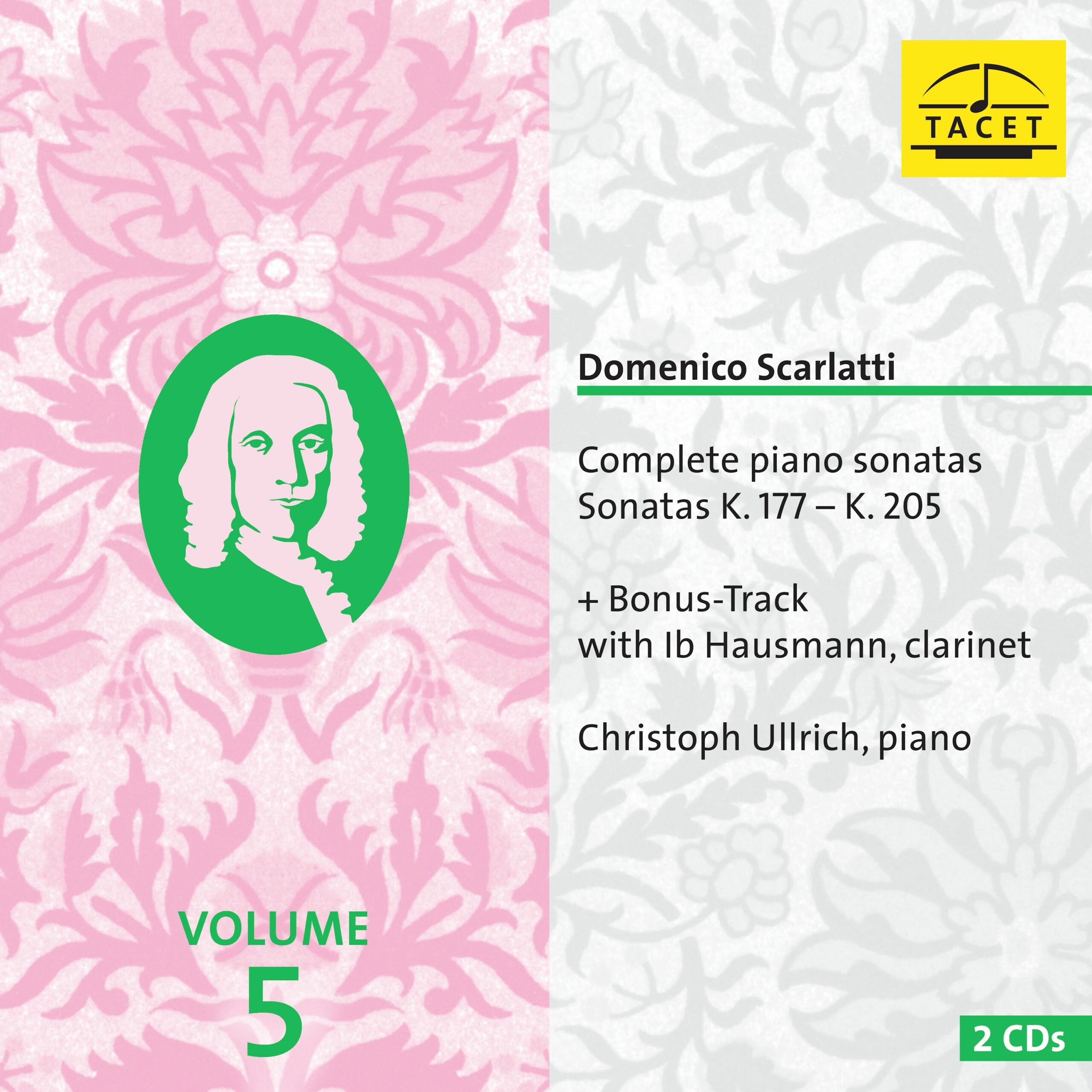
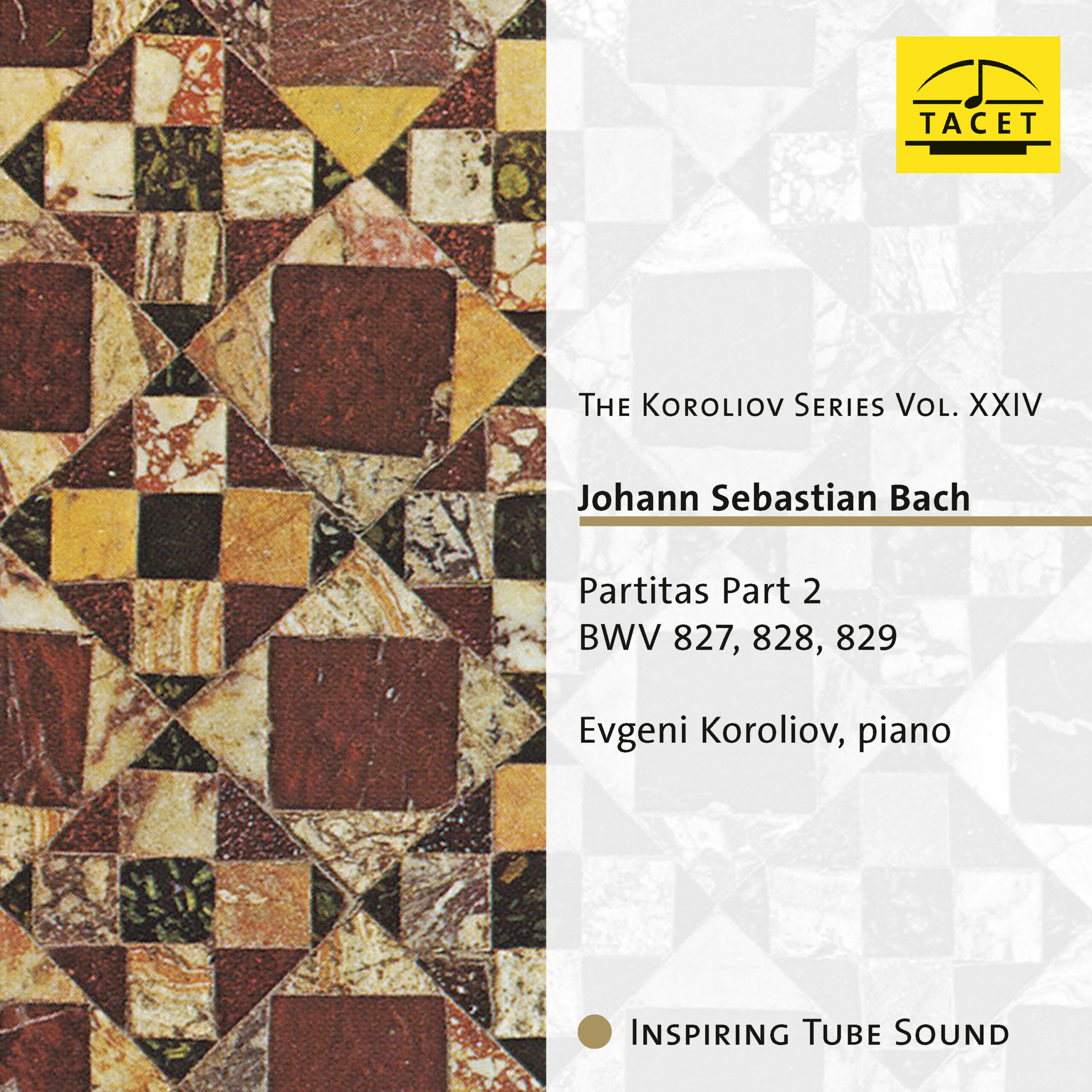
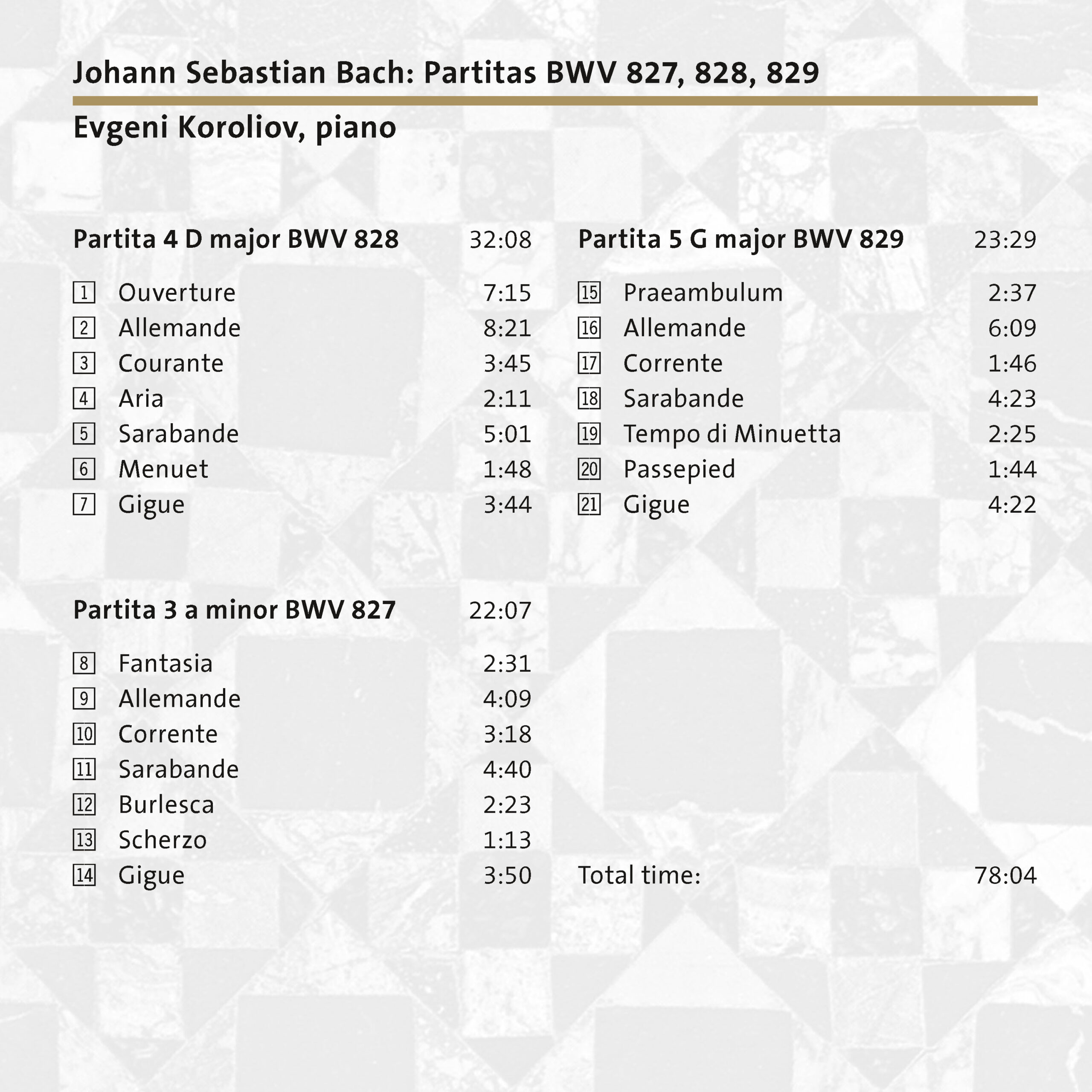


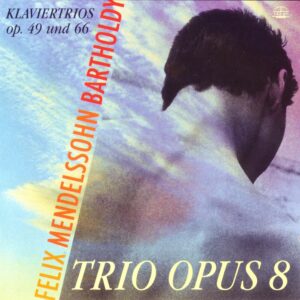
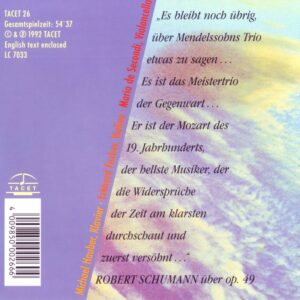
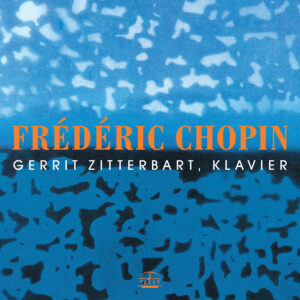
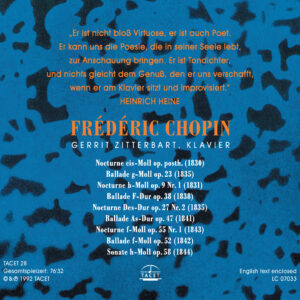
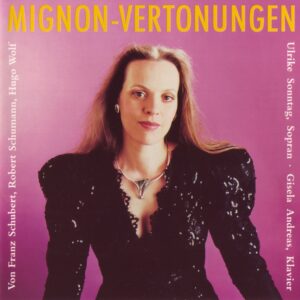
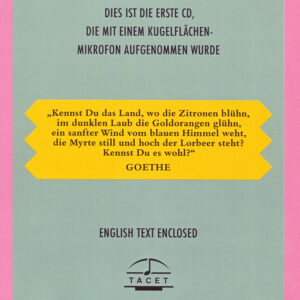
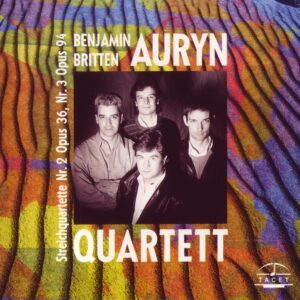
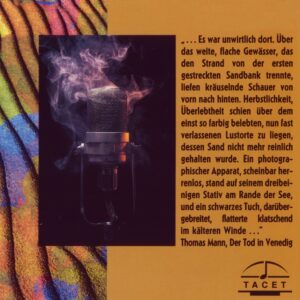
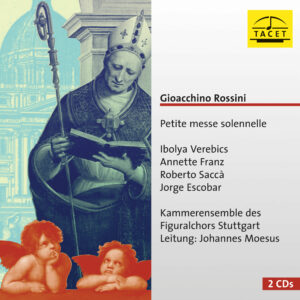
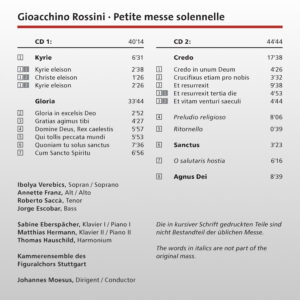

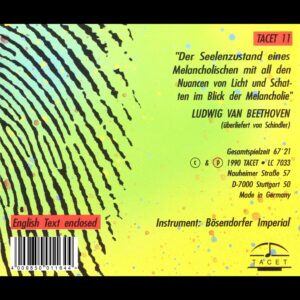
Fanfare-Magazin –
--> original review
Evgeni Koroliov is perhaps most famous for his Bach, though he has recorded everything from Chopin and Prokofiev to Handel, Beethoven, Haydn, and Schumann. In regard to his Bach, I have long admired not just his fabulous quasi-Gouldian Goldberg Variations but his equally spectacular Art of Fugue, a recording made (in)famous by the composer György Ligeti’s remark—“Were I allowed to take only one work with me to a desert island, I would choose Koroliov’s Bach, since even if I were alone, starving and dying of thirst, I could happily listen to this record over and over again until I took my last breath.” Give me a burger and a beer to go along with Koroliov’s AOF on that desert island and I think Ligeti might have something!
What Koroliov brings in spades to these three partitas is a sense of grandeur and architecture as well as freedom of phrasing. What could sound overbearing and overly Romantic in the way he stretches out melodies, delays notes, and uses rubato throughout the recital here feels completely natural: just witness how he shapes and reshapes the melodic contours of the D-Major Allemande, the A-Minor Sarabande, or especially the G-Major Allemande to fit his quasi-improvised/quasi-Romantic approach. His playing at times feels anti-metrical, yet somehow it not only works, but it also captivates. His slightly slower tempo in the concluding A-Minor Gigue may not be to everyone’s liking—comparing it to the steadier and more alert renditions by Gould and Perahia, I’m not sure that I love it—but even here Koroliov has the magical ability to convince you of his way being, if not the correct way, certainly a valid way of interpreting this music.
Where he really does shine for me is in moments of joyous abandon—the fabulously light and bouncy opening G-Major Praeambulum, with its numerous scales that seem to dance up and down the gamut of the Baroque keyboard; the energetic D-Major Gigue which brings that whole partita to its joyous culmination; or the opening A-Minor Fantasia which sets an air of mystery and—dare I say it?—fantasy from which the whole work seems to take its impetus. What Koroliov does better than many is to truly characterize each partita, one from the other, as well as each movement within the work itself. Were I able to dance a courante, Koroliov would be my ideal accompanist.
If you love your Bach played strictly and metrically, then perhaps it would be best to stick with Gould, Perahia, or Hewitt in these works—all of these are recommended sets in addition to András Schiff’s later ECM recording. But if you like your Bach with just a bit of fantasy and Romantic flair, then you’d be hard pressed to find a better rendition than Koroliov’s fabulous recording here. The pianist here finally gives me the perfect retort to Bach’s claim that “all one has to do is hit the right keys at the right time and the instrument plays itself.” Nonsense! Why would we ever need to hear more than one artist in a single work? What about the music between the notes?
© 2025 Fanfare
Scott Noriega
American Record Guide –
This is Volume 24 in the Koroliov Series by this label. It says it is “Partitas Part 2”. We missed Part 1 in 2020 (Partitas 6, 1, and 2), so I bought that to be able to enjoy and comment on it as well. Noting the uncom- monly refined musicianship of his perform- ances, I wanted all 6 of these suites played by this pianist. Volume 1 overflowed the playing time of a single CD by a few minutes, so that Partita 2 had to be issued on a disc by itself in that 2CD set. That overflow problem would have happened again this time with Partitas 3, 4, and 5, except that Koroliov has chosen to omit the second repeat in the long Alle- mande of Partita 4. His unhurried interpretation is appeal- ing. The music has plenty of time to speak. He understands that 17th and 18th Century Gigues were not helter-skelter breathless rushes like we got a few months ago from Francesco Tristano (March/April). In the long review of Tristano’s set, I gave reasons for mentioning 10 other pianists whose sets of Partitas I like better. Compared with those, Koroliov’s aesthetic choices are most like the slowest and gentlest one: the inti- mate performances from Wolfgang Rubsam (May/June 1994). Koroliov, like Rubsam, is almost too serene with some of the pieces here, espe- cially the boisterous parts of Partita 4 that are some of the grandest harpsichord pieces that Bach wrote. Despite the underplaying of those big moments, I would rather have this than any banging or one-dimensional aggression. Listen when in the mood to hear something contemplative. I hadn’t been in the market for yet another piano set of the Bach partitas, but I am glad now to have them for hearing this mellow side of the pieces. The unexplained promise of “inspiring tube sound” on the front cover didn’t contribute to the decision, though the recorded sound is indeed excel- lent. The 2020 and 2023 sessions match well in tone and clarity. Koroliov’s exquisite piano tone has been the biggest factor in my enthusiasm.
Bradley Lehman
[automatische Übersetzung der Originalkritik]
www.clicmusique.com –
–> Französische Originalkritik
With this recording, the Russian pianist Evgeni Koroliov, born in 1949 in Moscow but a resident of Hamburg since 1978, a specialist in renowned discographic series (Tchaikovsky, Schubert, Debussy, Chopin, Beethoven, Brahms, Ravel, Stravinsky), presents the second installment of his complete recording of Johann Sebastian Bach's keyboard partitas (Koroliov Series Vol. XXIV). Specifically, these are the BWV 827 in A minor, BWV 828 in D major, and BWV 829 in G major. Even though four years separate this volume from the first (the BWV 825 in B-flat major, 826 in C minor, and 630 in E minor), recorded in 2020, there is nothing to add or subtract from the excellent commentary that Jean-Charles Hoffele published in 2021 (ClicMag No. 91, TACET265). Indeed, without resorting to the absence of legato and the dactylographic rhythm and meter of a Glenn Gould, these are highly thoughtful and considered interpretations that allow us to hear timeless music thanks to an instrument that has itself become timeless through touch, timbres, and colors that the performer adds, all while striving to efface himself. A curious and troubling paradox, but one that will be particularly admired by lovers of an aesthetic so far removed from the rigors of philological reconstruction and the highly personal appropriations of the texts as demonstrated by the interpretations of the Kantor by Backhaus, Richter, Perahia, or Brendel. It is no surprise, then, that a Ligeti could confess: "If I had to take only one work with me to a desert island, it would be Koroliov's Bach, because alone, dying of hunger and thirst, I would listen to it and relisten to it until my last breath." For the unconditional, then.
Jacques-Philippe Saint-Gerand
[Automatische Übersetzung]
_________________________________________
Französischer Ursprungstext:
Avec cet enregistrement, le pianiste russe Evgeni Koroliov, né en 1949 à Moscou, mais Hamburger depuis 1978, spécialiste de séries discographiques de renom (Tchaikovski, Schubert, Debussy, Chopin, Beethoven, Brahms, Ravel, Stravinski), propose le second volet de son intégrale des Partitas pour clavier de Jean-Sébastien Bach (Koro¬liov Series Vol. XXIV). En l’occurrence les BWV 827 en la mineur, BWV 828 en ré majeur et BWV 829 en sol majeur. Même si quatre années séparent ce volume du premier (les BWV 825 en si bémol majeur, 826 en ut mineur et 630 en mi mineur), enregistré en 2020 il n’y a rien à ajouter ni à retrancher à l’ex¬cellent commentaire que Jean-Charles Hoffele publiait en 2021 (ClicMag n° 91, TACET265). En effet, sans recourir à l’absence de legato, et à la rythmique ainsi qu’à la métrique dactylogra¬phiques d’un Glenn Gould, voici des interprétations hautement réfléchies et pensées qui donnent à entendre une musique intemporelle grâce à un instru¬ment devenu lui-même intemporel par le toucher, les timbres et les couleurs que l’interprète y adjoint. tout en s’ef¬forçant de s’effacer lui-même. Curieux et troublant paradoxe, mais qui sera particulièrement admiré par les ama¬teurs d’une esthétique si éloignée des rigueurs d’une reconstruction philolo¬gique et des appropriations des textes tellement personnelles que celles dont témoignent en regard les lectures du Kantor que donnèrent Backhaus, Rich¬ter, Perahia ou Brendel. Guère étonnant qu’un Ligeti ait pu avouer: „Si je devais n’emporter avec moi qu’une seule œuvre sur une île déserte, ce serait le Bach de Koroliov, car, tout seul, mou¬rant de faim et de soif, je ne cesserais de l’écouter et réécouter jusqu’à mon der-nier souffle“. Pour inconditionnels donc.
Jacques-Philippe Saint-Gerand
Audio und Stereoplay 3/25 –
Audio und Stereoplay Klangtipp / Klassik-CD des Monats
Bach enthusiasts had to wait a bit for the Moscow-born pianist Evgeni Koroliov, who has lived in Hamburg since 1978, to complete the cycle of the six partitas, which Johann Sebastian Bach (1685–1750) had printed in 1731 as his Opus 1 (!), one of his most demanding works for keyboard instruments. As in Volume 1, released on two CDs in 2020, Koroliov once again takes us deep into a wonderful world on his Steinway. Free from any gimmicks, this technically flawless performance flows effortlessly, carefully illuminating every detail without ever being harsh. Where others over-accentuate rhythmically or rush through nuances, Koroliov remains thoughtful and lyrical. The recording in Tacet's "Inspiring Tube Sound" perfectly contributes to this unobtrusive, deeply effective balm for the soul.
Lothar Brandt
Klassik heute –
--> original review
Klassik heute Recommendation
The Russian pianist Evgeni Koroliov, born in Moscow in 1949 and living and working in Hamburg since 1978, has long been regarded as a top-tier Bach specialist (despite the breadth of his repertoire); Ligeti's hymnic praise of Koroliov's recording of The Art of Fugue is often quoted. While this recording was one of the very first Tacet productions in 1990, Koroliov has since released a whole series of Bach CDs, including the Goldberg Variations, both books of The Well-Tempered Clavier, and the French Suites. Overall, Koroliov takes his time with new recordings, and after the release of Partitas Nos. 1, 2, & 6 in 2020, the latest album now features their three sister works (Nos. 3 to 5).
Eminent inner peace and serenity
Having "matured" over the years, recordings of the highest spirituality and introspection have emerged. Koroliov's Bach playing is characterized by an eminent inner peace and serenity, carried by a warm, softly glowing timbre and rather restrained tempi, held in a very melodic and cantabile manner, while simultaneously bringing out the polyphonic structures with impressive sovereignty and clarity. Here, the voices are carefully graded against each other, dialoguing with one another, emerging and receding, imbued with detail. Koroliov fundamentally plays a rather free Bach with considerable rubato, sometimes with brief tempo changes, occasionally seeming improvisatory and exploratory, especially in the opening movements, with a keen sense of the range of tonal colors that a modern grand piano can offer. Just listen, for example, to the ethereal, almost flageolet-like beginning of the Sarabande from Partita No. 4!
Excellent representation of the characteristics of music.
Overall, Koroliov emphasizes less the dance character of the individual movements and instead abstracts from it, focusing more on the characteristics of the music. The three gigues at the end of the partitas can serve as examples of this. The two extremes are represented by the gigue of Partita No. 4, which Koroliov interprets as bright-extroverted, driving forward, and distinctly motoric—not in the sense of seeking extremes in interpretation, but within the context of his own recording, for instance, by largely avoiding rubato here, unlike elsewhere—and, on the other hand, the gigue of Partita No. 3, which he understands as much softer, more restrained, and certainly more hesitant. Interestingly, this gigue is one of only three movements on this CD where Koroliov omits the repetition of the second part (the other two are the courante and the sarabande of Partita No. 4), possibly to give the brightening at the end a certain singularity.
Sovereign creative power and variability.
Otherwise, Koroliov demonstrates sovereign creative variability in the numerous repetitions, not only and certainly not excessively in the form of ornamentation (which Koroliov likes to incorporate anyway, always proceeding very tastefully and in moderation). Actually, it is primarily a play with subtle changes in the characteristics of the music that Koroliov engages in here, shaped through flexible agogics, changes in articulation or dynamics, the incorporation of arpeggios, or very slight variants in the musical text. This can be beautifully observed, for example, in the first part of the Overture of Partita No. 4: starting from the magnificent, which Koroliov imbues more with a gentle-solemn glow than with pomp, the music breathes in a large, masterfully celebrated arc up to the double bar, only to trace this movement again in the second attempt with a touch more introspection and contemplation.
A magnificent, very coherent album
What is perhaps most fascinating about all this is Koroliov's enormous sense of the right measure: his approach never feels forced or schematic, never does he point with his finger at something, but rather, with the greatest subtlety and inspiration, he explores fine nuances, always letting the music speak first and giving its natural flow space. The accompanying text by Thomas Seedorf, though rather short, is also excellently done, stimulating and drawing attention to some carefully selected aspects. A magnificent, very coherent album, incidentally also excellent in terms of sound, with a spatial acoustic that gently allows the sound of the grand piano to unfold.
Holger Sambale
Rondo. Das Klassik & Jazz Magazin –
--> original review
[…] In all three works, he takes the listener on a kind of nocturnal journey of the soul, which, with great sensitivity and a restrained, introverted tone, illuminates the depths of the soul behind the prescribed dance types here. […]
Attila Csampai
Pizzicato –
-> original review
Pianist Evgeni Koroliov presents the second part of the Bach Partitas and seamlessly continues the level of the first recording.
Back then, my colleague Alain Steffen spoke of an intimist Bach, and this is confirmed here. Koroliov’s Bach is a Bach of quiet tones that give the music something timeless and non-representational. It is actually pure magic that is heard here, a tranquil balm of touching beauty.
Koroliov’s playing is, how could it be otherwise, technically perfect, his tempi optimally chosen and his colorful sound of captivating purity. The recording is wonderfully natural and thus suits the pianist’s playing one hundred percent.
Remy Franck